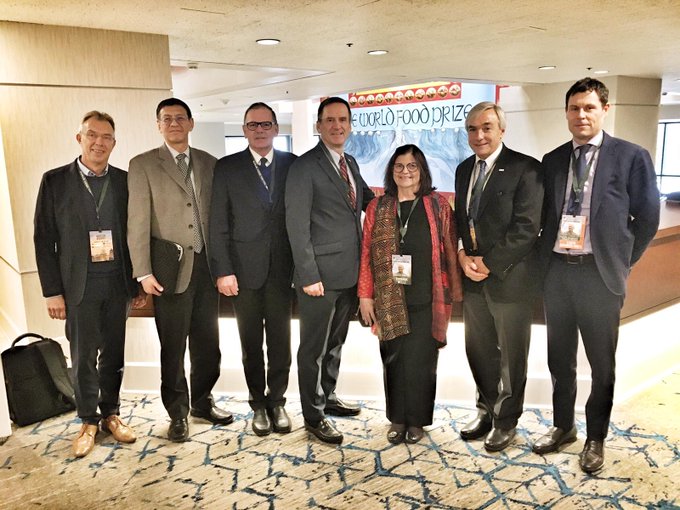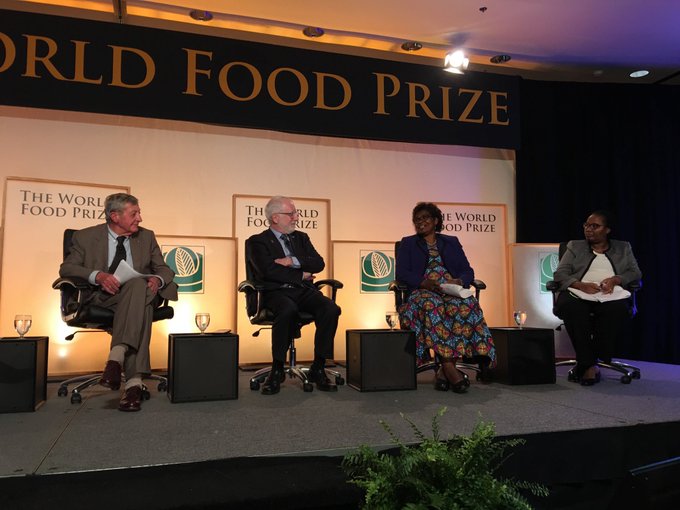Launch of the “Crops to End Hunger” Initiative

Crops to end hunger
16 October 2019. The "Borlaug Dialogue" brings together over 1,200 people each year from more
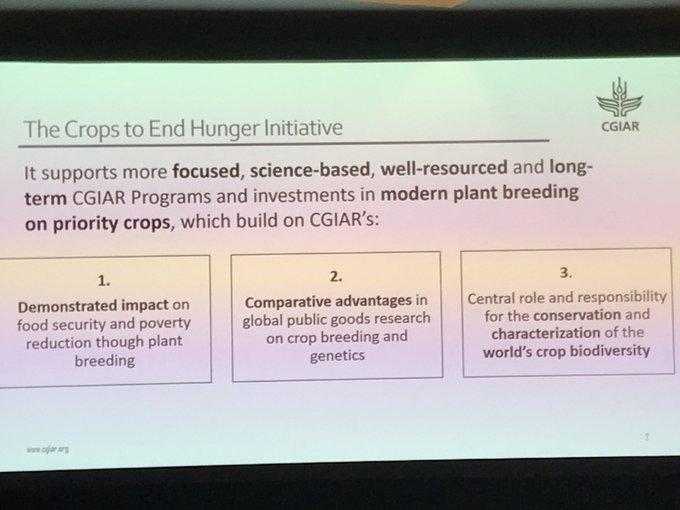 than 65 countries to address cutting-edge issues related to global food security and nutrition. The three-day conference convenes a wide array of scientific experts, policy leaders, business executives and farmers and has been called "the premier conference in the world on global agriculture." Through the Borlaug Dialogue, the World Food Prize Foundation helps build alliances in the struggle against world hunger and malnutrition.
than 65 countries to address cutting-edge issues related to global food security and nutrition. The three-day conference convenes a wide array of scientific experts, policy leaders, business executives and farmers and has been called "the premier conference in the world on global agriculture." Through the Borlaug Dialogue, the World Food Prize Foundation helps build alliances in the struggle against world hunger and malnutrition.
Extract of the programme: CGIAR at the World Food Prize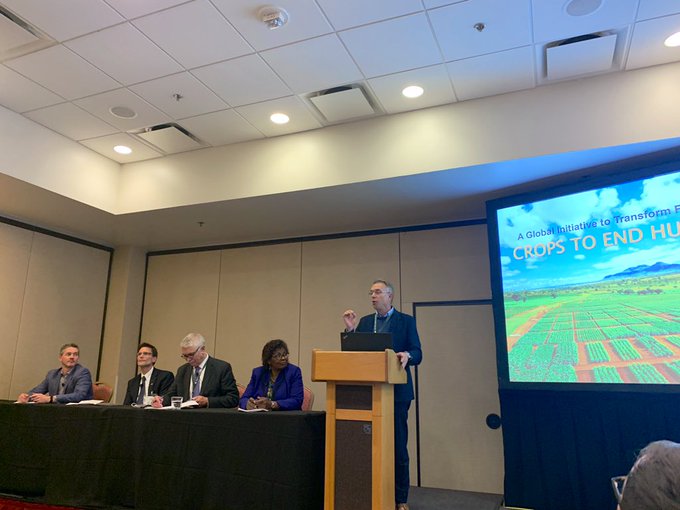 The challenge of CGIAR is to apply modern scientific advances toward achieving the Sustainable Development Goals (SDGs), particularly SDG 2: “End hunger, achieve food security and improve nutrition, and promote sustainable agriculture.” In service of this mission, CGIAR introduced “Crops to End Hunger,” an initiative focused on increasing the effectiveness of CGIAR crop breeding programs in developing
The challenge of CGIAR is to apply modern scientific advances toward achieving the Sustainable Development Goals (SDGs), particularly SDG 2: “End hunger, achieve food security and improve nutrition, and promote sustainable agriculture.” In service of this mission, CGIAR introduced “Crops to End Hunger,” an initiative focused on increasing the effectiveness of CGIAR crop breeding programs in developing
more productive, resilient and nutritious varieties of staple crops in demand by smallholder farmers and consumers in the developing world.
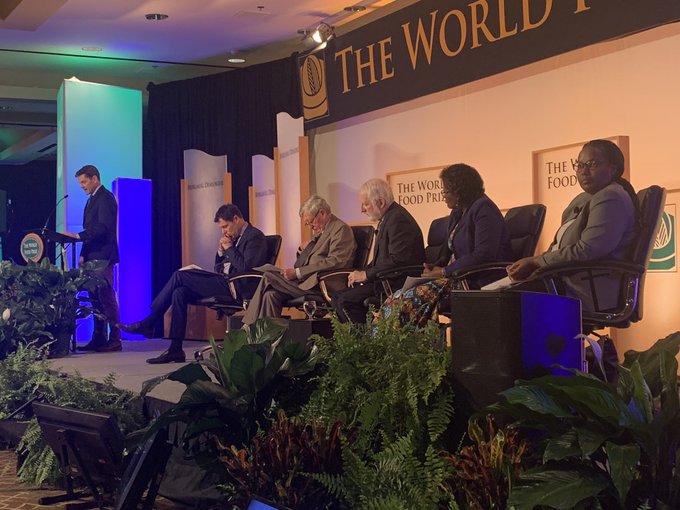 The official launch of “Crops to End Hunger” introduced and outlined this new ambitious vision to meet the food, nutrition and income needs of both producers and consumers, respond to market demands, and provide resilience to environmental challenges arising from the climate crisis.
The official launch of “Crops to End Hunger” introduced and outlined this new ambitious vision to meet the food, nutrition and income needs of both producers and consumers, respond to market demands, and provide resilience to environmental challenges arising from the climate crisis.
 than 65 countries to address cutting-edge issues related to global food security and nutrition. The three-day conference convenes a wide array of scientific experts, policy leaders, business executives and farmers and has been called "the premier conference in the world on global agriculture." Through the Borlaug Dialogue, the World Food Prize Foundation helps build alliances in the struggle against world hunger and malnutrition.
than 65 countries to address cutting-edge issues related to global food security and nutrition. The three-day conference convenes a wide array of scientific experts, policy leaders, business executives and farmers and has been called "the premier conference in the world on global agriculture." Through the Borlaug Dialogue, the World Food Prize Foundation helps build alliances in the struggle against world hunger and malnutrition.Extract of the programme: CGIAR at the World Food Prize
1- Launch of the “Crops to End Hunger” Initiative
 The challenge of CGIAR is to apply modern scientific advances toward achieving the Sustainable Development Goals (SDGs), particularly SDG 2: “End hunger, achieve food security and improve nutrition, and promote sustainable agriculture.” In service of this mission, CGIAR introduced “Crops to End Hunger,” an initiative focused on increasing the effectiveness of CGIAR crop breeding programs in developing
The challenge of CGIAR is to apply modern scientific advances toward achieving the Sustainable Development Goals (SDGs), particularly SDG 2: “End hunger, achieve food security and improve nutrition, and promote sustainable agriculture.” In service of this mission, CGIAR introduced “Crops to End Hunger,” an initiative focused on increasing the effectiveness of CGIAR crop breeding programs in developingmore productive, resilient and nutritious varieties of staple crops in demand by smallholder farmers and consumers in the developing world.
 The official launch of “Crops to End Hunger” introduced and outlined this new ambitious vision to meet the food, nutrition and income needs of both producers and consumers, respond to market demands, and provide resilience to environmental challenges arising from the climate crisis.
The official launch of “Crops to End Hunger” introduced and outlined this new ambitious vision to meet the food, nutrition and income needs of both producers and consumers, respond to market demands, and provide resilience to environmental challenges arising from the climate crisis.
- Simon Groot, Founder, East-West Seed, and 2019 World Food Prize Laureate
- Rodger Voorhies (see picture), President, Global Growth and Opportunity, Bill and Melinda Gates Foundation
“Unless we anchor into the adaptations to climate change, changes of seed production and adapted varieties, smallholder farmers will be left behind." - Neal Gutterson, Chief Technology Officer, Corteva Agriscience
- Hon. Gerardine Mukeshimana, Minister of Agriculture and Animal Resources, Rwanda
- Felister Wambugha Makini, Deputy Director General Crops – Crops Division, KALRO, Kenya
- Elwyn Grainger-Jones, Executive Director, CGIAR System Organization
2- Unpacking “Crops to End Hunger”
- Dr. Geoff Graham Head of Plant Breeding Corteva Agriscience
- Dr. Gary Atlin Senior Program Officer Bill and Melinda Gates Foundation
- Dr. Michael Quinn Director CGIAR Excellence in Breeding Platform (EiB)
- Dr. Robert Bertram Chief Scientist, Bureau for Resilience and Food Security USAID
- Dr. Felister Wambugha Makini Deputy Director General Crops – Crops Division KALRO, Kenya
Digitalization and access to information with 80% of Kenyans having a mobile phone - Dr. Martin Kropff Director General International Maize and Wheat Improvement Center (CIMMYT)
- Moderator Dr. Marco Ferroni Chair CGIAR System Management Board
 What is Crops to End Hunger?
What is Crops to End Hunger?
Crops to End Hunger (CtEH) is a CGIAR initiative to accelerate and modernize the development, delivery and widescale use of a steady stream of new crop varieties. These new varieties are developed to meet the food, nutrition and income needs of both producers and consumers, respond to market demands and provide resilience to pests, diseases and new environmental challenges arising from climate change.
- This initiative aims to accelerate a transition in CGIAR crop breeding for human consumption to address very different challenges from those faced in the green revolution.
- 20 CGIAR crops, including cereals, legumes and root crops, have been chosen for this breeding initiative.
- The first step towards modernization of breeding programs is to identify the gaps – the areas that need to be addressed or improved. The Breeding Program Assessment Tool (BPAT) has been developed for this purpose. The deployment of BPAT has been administered by the University of Queensland and has now been used to assess the breeding programs across CGIAR Research Centers.
- Examples of gaps include cross-CGIAR data management tools, access to low-cost genotyping, and sharing high-quality technical advice across programs and with partners.
- See: CGIAR System 3-Year Business Plan (2019-2021) Companion Document Initiative on “Crops to End Hunger” Strategy and Options for CGIAR Support to Plant Breeding; 31 October 2018, 60 pages
The 20 crops analysed in the prioritization studies were:
Cereal grains: rice, maize, wheat, sorghum, millet, barley
Roots, tubers and banana (RTB): potato, cassava, yams, sweet potato, banana, plantain
Oilseeds and pulses: Pulses (aggregate); beans (Phaseolus); chickpea (Cicer); cowpea (Vigna unguiculata); pigeon pea (Cajanus); lentil (lens); other pulses (pisum); groundnuts; soybean (SSA only).
Cereal grains: rice, maize, wheat, sorghum, millet, barley
Roots, tubers and banana (RTB): potato, cassava, yams, sweet potato, banana, plantain
Oilseeds and pulses: Pulses (aggregate); beans (Phaseolus); chickpea (Cicer); cowpea (Vigna unguiculata); pigeon pea (Cajanus); lentil (lens); other pulses (pisum); groundnuts; soybean (SSA only).
Related:
#FoodPrize19 #CGIARatWFP #OneCGIAR @WorldFoodPrize @CGIAR @Cipotato @IFPRI @CIMMYT @CIAT_ @ICRISAT @IITA_CGIAR Forthcoming: 2019. Wheat breeding Handbook at ICARDA. Pp-, Beirut, Lebanon. CWANA accounts for more than 50% of the wheat production area in the developing world. pic.twitter.com/JettQxS4EA
— ICARDA (@ICARDA) October 17, 2019
Related: Simon Groot, Founder, East-West Seed, and 2019 World Food Prize Laureate.
Initially, Simon Groot struggled in the Philippines because “farmers are extememly reluctant to go in for seeds.” Switching from underperforming free seeds to hybrid seeds with higher yields has the initial burden of taking the financial investment into seeds
Related: BBC Release date:10 October 2019. The man who fed the world - Duration: 4 minutes
In 1970 the American agri-scientist, Norman Borlaug, was awarded the Nobel Peace Prize for his pioneering work developing disease-resistant crops. At the time famine and malnutrition were claiming millions of lives across the world, particularly in South Asia. Dr Borlaug’s work meant countries like India were able to become self-sufficient. Critics said the new grain varieties were too reliant on chemical fertilisers, but it’s thought millions of lives were saved. Witness History hears from Professor Ronnie Coffman, student and friend of Norman Borlaug.

